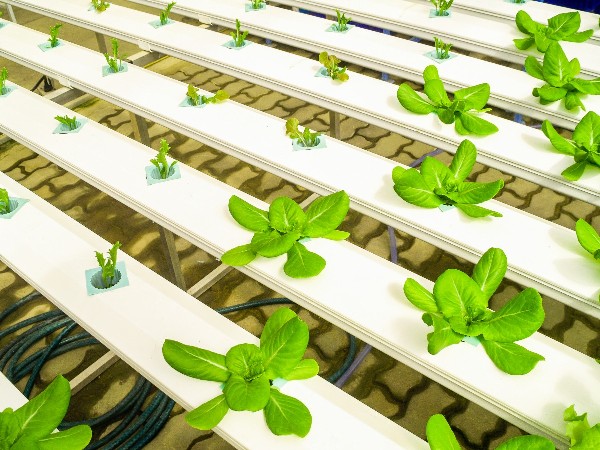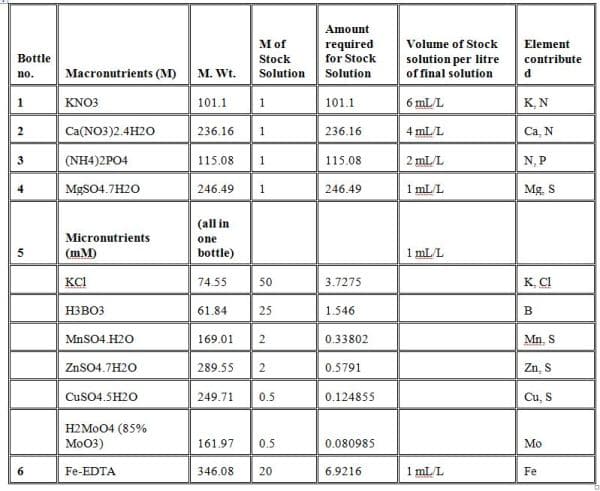Homemade Hydroponic Nutrient Solution
Today, we are into a discussion of homemade hydroponic nutrient solution.
Making your own Hydroponic Nutrient Solution
When Plants are grown in the soil they can easily get essential nutrients from the mother earth, but in a hydroponic system, you become the guardian. It’s up to you to make sure everything they require is in the nutrient mixture that you are providing that too in appropriate proportions so that you can witness their best yield.
Sure, you could just buy a premixed ready to use nutrient solution with one click, but what’s the fun in that?
Having a hydroponic garden is itself a reward and motivation. For managing your hydroponic garden relying on the readymade premixed nutrient solution is only a quick fix. To obtain a better yield from your hydroponic garden you need to understand what nutrients they need and most important when and how much they need? All you need is to have some time, the right procedure for making a tonic for your little hydroponic plants. And for this, we are here to tell what’s and how’s of making a nutrient solution.
So be ready for an easy and rewarding process of making own hydroponic nutrient solution at home.
Making your own nutrient solution allows you to fine-tune the level of each nutrient to your plants’ exact requirements, and you can save a lot of money in the long run. Preparing your own hydroponic nutrient solution is easy. It simply needs some preparation and a keen eye.
Before moving to full flash steps of making hydroponic nutrient solution first we need to understand what are nutrients? Why do plants require nutrients? What nutrients do? How do they work?.
So first you should know your plants, and know what and how much they need before you begin because each nutrient corresponds to a different function within the plant and also individual plant needs different types of nutrients.

What are hydroponic nutrient solutions?
Plants require nitrogen, phosphorous, and potassium (N-P-K), and numerous trace elements for their growth and development. Nutrients are categorized into two classes on the basis of their amount required: macronutrients and micronutrients or trace nutrients. Essential elements categorized as macronutrients are elements that are used in higher concentrations than micronutrients. Even though micronutrients are used in lower concentrations, it doesn’t mean they are any less essential. There are six essential elements classified as macronutrients: nitrogen (N), phosphorus (P), potassium (K), calcium (Ca), magnesium (Mg), and sulfur (S). The eight essential elements categorized as micronutrients: iron (Fe), manganese (Mn), chlorine (Cl), boron (B), zinc (Zn), copper (Cu), molybdenum (Mo), and nickel (Ni). Collectively these 14 mineral elements make up the essential elements that are found in a complete hydroponic nutrient regiment necessary for the growth of plants. The liquid nature of the hydroponic nutrients allows them to be applied directly to the plant’s root system and nourish the plants under cultivation.
Read: How To Grow Vegetables in Terrace Garden.
Types of hydroponic nutrient solution
All plants depend on the same type of primary macronutrients and micronutrients, but their concentration in solution will vary based on what you are growing. The ratios of the micronutrients, macronutrients and beneficial elements in a hydroponic solution will vary depending on a spectrum of factors. The type of crop, stage of growth and various environmental factors all come into play when fine-tuning a hydroponic nutrient solution. The hunt for a one-size-fits-all nutrient formulation has been largely indecisive. Although the following standard formulas are widely used:
Hoagland Solution
The nutrient solution commonly famous as the “Hoagland solution” was formulated and published by D.R. Hoagland and D.I. Arnon in 1950. The duo measured the concentration of nutrients in a tomato plant (Lycopersicon esculentum) growing in a hydroponic solution. From that analysis, they determined which nutritional elements the plant drew from the solution and their function. The formulation is reasonably high in nitrogen and potassium, and it is mainly well-suited to large fruiting plants such as tomatoes and peppers (Capsicum spp.). Nutrient solutions based on the Hoagland formula are widely utilized by hydroponic growers.
For curious minds the recipe of Hoagland solution with nutrient solution composition is as follows:
Reference: Hoagland and Arnon, 1950

The procedure of making Hoagland solution as part of a homemade hydroponic nutrient solution:
Stock Solution
- Take 6 plastic bottles and wash them thoroughly. Label each bottle with the help of a marker pen from 1 to 6 or as desired.
- Prepare a molar solution of macro-nutrients and mM solutions for micro-nutrients by dissolving the quantity given in the “Amount required for Stock Solution” column in above table carefully.
- Put each nutrient stock solution in a separate bottle to avoid confusion. All macro-nutrients will be combined in one bottle. Have patience and do not mix unless needed because it would precipitate immediately.
- Store in a refrigerator at 4˚C.
- Remember these calculations are per liter basis. To calculate different molarity for different volume, you will need to recalculate the given quantities.
Read: A Guide for Starting a Hydroponics at Home.
For the working solution
- Take one liter of water (tap or distilled) in an open container so that it facilitates mixing.
- Use the given quantity of stock solution from each bottle as shown in “Volume of stock solution per liter of final solution” of the table say if you would need 6 ml of KNO3 from bottle 1 per liter of water.
- Suppose if you wish to prepare the half-strength Hoagland’s nutrient solution, just double the quantity of tap water (i.e. 2 L) or you can use half quantity of stock (e.g. 3 ml of KNO3 per liter).
Precautions to be taken when preparing Hoagland nutrient solution:
For stock solution
- Preferably use laboratory grade salts from reliable sources to prepare stock solutions.
- Keep each stock solution in a separate labelled bottle and do not mix before use.
- Keep the stock bottles tightly sealed means airtight.
- Do not use the STOCK solution if you observe any precipitation in the stock bottle.
- The shelf life of stock solution is about 6 months (after proper storage) unless any precipitation occurs earlier.
For a working solution
- Always freshly prepare working solution just before use by mixing the given quantity as shown in the tables above.
- Never store the working solution for more than 3 days.
- Check the pH of working solution, and if necessary adjust to pH 5.8 to 6.3 with addition 1M KOH (base) or HCl (acid). If you do not want to change the K concentration then opt for NaOH but be sure because it adds Na.
Steiner Solution
Rather than focusing on the nutrient uptake of a particular plant, Abram Steiner in 1968developed a formula for a nutrient solution with the conjecture that a universal proportion of nutrients would be most favorable for all plants. He explained that plants are capable to take whatever nutrients they require from a solution as long as the nutrients are available and that plants would pay out less energy absorbing nutrients when the nutrients are present already in an optimal ratio, which allows a more accurate control that offers potential for increased production and improved quality of plants under cultivation. Steiner solution provides a bunch of micronutrients suitable for foliage and flowering plants than a solution developed for fruiting plants.
The pros of using Premixed Solutions:
- Hydroponic hobbyists and small-scale growers often prefer premixed solutions that eliminate the headache of calculating nutrient ratios.
- These solutions are easily available in the market in both liquid and powdered forms.
- They are relatively less expensive when compared to the cost of buying the individual elements for mixing to create a solution.
The cons of using Premixed Solutions:
- Premixed solutions, don’t allow for adjustments based on the particular needs of the plants being grown. Hence usually commercial growers tend to use self- tailored nutrient formulations.
Points to be taken care of in a homemade hydroponic nutrient solution:
- If the container of your hydroponic system holds a lot of water, mix nutrients in more than one batch.
- Don’t overfill your container or the nutrients may spill and get wasted when you mix them.
- Used the nutrient solution immediately once it’s mixed, since it may lose some of its strength when stored and even may get precipitated.
- If the water level drops between changes, due to evaporation or absorption, use only plain or water for replacing it. Adding new nutrient solution to the older one can cause an imbalance and fabricate unwanted salts that can harm your plants.
Read: How To Grow Hydroponic Lettuce.
Hi Jagdish,
I’m a newbie to hydroponics and already very keen to try building my very own system. I have a lot of questions and I think connecting with you would be extremely valuable for me. Would you like to connect over mail? Awaiting your response.